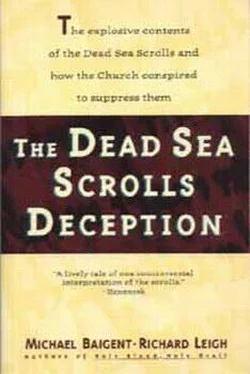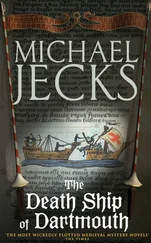13. Eisenman, James the Just in the Habakkuk Pesher, p. 3.
13. James ‘The Righteous’
1 While Acts never explicitly states that James is the ‘leader’ of the Jerusalem community, in Acts 15:13-21 and 21:18 he has a prominent role. The latter tellingly states that ‘Paul went… to visit James, and all the elders were present’. This puts the elders in a subordinate position to James. Paul, in his letter to the Galatians (2:9), states: ‘James, Cephas and John, these leaders, these pillars’. Later, this same letter (2:11-12) clearly shows that Cephas is subordinate to James (Cephas = Peter). John is barely mentioned in Acts after the introduction of Paul. Later Church writers specifically call James the leader of the early ‘Christians’.
2. For example, James 2:10: ‘if a man keeps the whole of the Law, except for one small point at which he fails, he is still guilty of breaking it all’. See Eisenman, James the Just in the Habakkuk Pesher, p.2, n.6; p.21, n.l; p.25; p.58 (n.39).
3. In the Greek text it reads as here. Curiously, The Jerusalem Bible translated primarily by de Vaux and the members of the Ecole Biblique obscures the sense with the reading: ‘It was you who condemned the innocent and killed them…’
4. Recognitions of Clement, I, 70.
5. Ibid.
6. Eisenman, when discussing this incident, notes that six weeks later, when in Caesarea, Peter mentions that James was still limping as a result of his injury. As Eisenman says, ‘Details of this kind are startling in their intimacy and one should hesitate before simply dismissing them as artistic invention.’ See Eisenman, op. cit, p.4, n.ll.
7. Recognitions of Clement, I, 71.
8. Josephus, Antiquities of the Jews, XX, ix.
9. Eusebius, The History of the Church, 2, 1; 2, 23.
10. Ibid., 2, 1.
11. A number of the older monasteries in Spain have, since their foundation, systematically collected all available texts both orthodox and heretical. As these monasteries have never been plundered, their holdings remain intact. Unfortunately, access to their libraries is severely restricted.
12. Eusebius, op. cit., 2, 23.
13. Eisenman, op. cit., p.3.
14. Ibid.
15. Eusebius, op. cit., 2, 23.
16. Eisenman, op. cit., p. 10.
17. Eusebius, op. cit., 2, 23.
18. Ibid.
19. Ibid. See also Eisenman, op. cit., p.28, n.12; p.60, n.40 (referring to Origen, Contra celsum, 1.47; 2.13).
20. Herod Agrippa II.
21. Eisenman, op. cit., pp.63-5.
22. The Habakkuk Commentary, II, 2 (Vermes, p.284).
23. Ibid., II, 3-4 (Vermes, p.284).
24. Ibid., V, 11-12 (Vermes, p.285).
25. Ibid., X, 9-10 (Vermes, p.288).
26. Ibid., X, 11-12 (Vermes, p.288).
27. For a comprehensive review of Paul’s sensitivity to the charge of lying, see Eisenman, op. cit., p.39, n.24.
28. Eisenman, op. cit., p.viii, points out the important difference between the ‘Liar’ and the ‘Wicked Priest’. This distinction must be made before any historical sense can be made of the texts. The consensus position is that the ‘Liar’ and the ‘Wicked Priest” are the same person. See Vermes, The Dead Sea Scrolls in English, p.30.
29. The Habakkuk Commentary, IX, 2 (Vermes, p. 287). See Eisenman, op. cit., pp.50-51, where he explains that the passage would read more accurately as: ‘they took vengeance upon the flesh of his corpse’. This relates the passage very closely to the known facts of Ananas’ death. See also Eisenman, ‘Interpreting “ Arbeit Galuto” in the Habakkuk Pesher’, which connects this phrase to the Sanhedrin trial of James.
30. The Habakkuk Commentary, XII, 7ff. (Vermes, p. 289).
31. Eisenman to authors, 22 August 1990.
32. The Habakkuk Commentary, VIII, Iff. (Vermes, p.287). See also Eisenman, op. cit., pp.37-9, for a discussion of this reference to ‘faith’.
33. Eisenman, ibid.
1. Eisenman, Maccabees, Zadokites, Christians and Qumran, p. 44, n.30.
2. Ibid., p.6.
3. Ibid., p.8; p.45, n.36 (quoting Wernberg-Meller).
4. Ibid., p. 12; p.49, n.58; see also p.26.
5. Ibid., p. 12.
6. Ibid., p. 13; p.49, n.58. See Numbers 25:7ff. Mattathias invokes this covenant in his dying speech (1 Mace. 2:54): ‘Phinehas our father, because he was deeply zealous, received the covenant of everlasting priesthood.’ (Revised Standard Version)
7. Eisenman to authors, 29 August 1990.
8. Ibid., pp. 13-16; p.45, n.36.
9. Ibid., p.44, n.30.
10. Ibid., p. 10.
11. Ibid., p.90, n.164. This terminology of ‘purist’ and ‘Herodian’ Sadducees derives from Eisenman. The ‘purist’ Sadducees, or the ‘Zealots’, were, after 4 bc, ‘Messianic’ in their ideology. Hence Eisenman refines his terminology on occasion to speak of the post-4 bc groups rather as ‘Messianic Sadducees’ and ‘Boethusian Sadducees’ — the latter after Simon ben Boethus, whom Herod established as high priest. In our text, we have retained the simpler division into ‘purist’ and ‘Herodian’ groups. This approach provides the key to understanding the ‘ MMT’ document.
12. Josephus, The Jewish Wars, II, i. See Eisenman, op. cit., pp.25-6.
13. Josephus, op. cit., II, iv.
14. Ibid., II, viii.
15. Eisenman, op. cit., p.53, n.79; p.75, n.140.
16. Josephus, Antiquities of the Jews, XVIII, i.
17. Ibid., XVII, x.
18. Josephus, The Jewish Wars, II, xvii.
19. Josephus, Antiquities of the Jews, XVIII, i.
20. This material received an early public airing in a paper given by Eisenman to the Society of Biblical Literature at its meeting in New York in 1981, ‘Confusions of Pharisees and Essenes in Josephus’.
21. The Interlinear Greek-English New Testament, Acts 21:20.
22. Eisenman, op. cit., pp.5-9.
23. Ibid., p.58, n.95.
24. Ibid., pp.36-7; p.90, n.164; p.96 (n.179).
25. Josephus, The Jewish Wars, VII, x; the translation of G.A. Williamson is used here (The Jewish War, pp.392-3).
26. Eisenman, op. cit., p.96, n.180.
27. Ibid., pp.25-6.
28. Ibid., p.73, n.132; listing The Damascus Document, VII, 18-21; The War Scroll, XI, 5ff; A Messianic Testimonia (4Q Test), 9-13.
29. The Damascus Document, VII, 18-21.
30. Tacitus, The Histories, V, xiii; the translation of K. Wellesley is used here (p.279). See also Suetonius, The Twelve Caesars, Vespasian, 4; translation by R. Graves (p.281).
31. Eisenman, op. cit., p.25.
32. Gichon, ‘The Bar Kochba War’, p. 88.
33. Ibid., p.92.
34. Ibid., pp.89-90.
35. Gichon to authors, 12 January 1990.
1. The last sentence of this quote from Matthew is a pure Qumran-style statement opposing the methods of ‘the Liar’.
2. Josephus, The Jewish Wars, VII, ix.
3. Ibid., VII, viii; the translation used is that of G.A. Williamson, The Jewish War, p. 387.
4. Ibid. (Williamson, p.390).
5. Ibid., Ill, viii.
6. Yadin, Masada, pp. 187-8. Yadin makes nothing of this fact. See Eisenman, Maccabees, Zadokites, Christians and Qumran, p. 22; p. 67 n.117.
7. Ibid., p.62 n.105.
8. The War Scroll, I, 6-8 (Vermes, p. 105).
16. Paul – Roman Agent or Informer?
1. Especially 1 Corinthians 9:19-27. See above, Chapter 11, n.8.
2. Eisenman to authors, 24 August 1990.
3. Eisenman, James thejust in the Habakkuk Pesher, p.16, n.39; p.59, n.39.
Читать дальше












